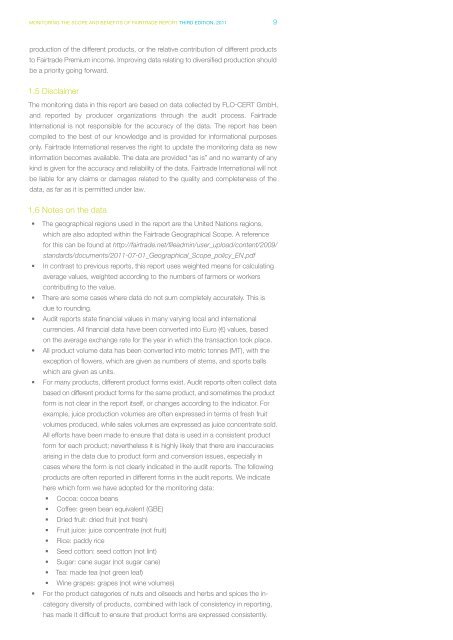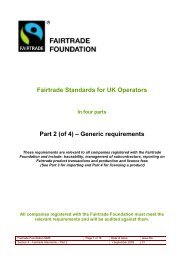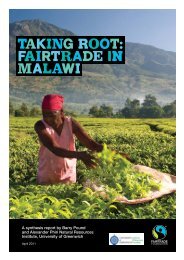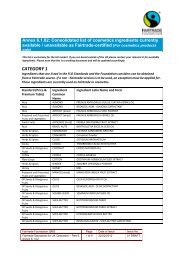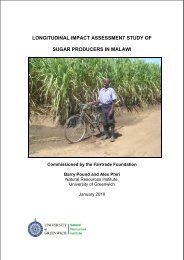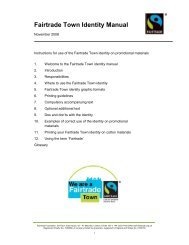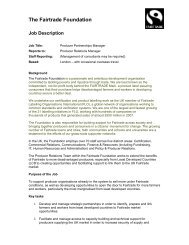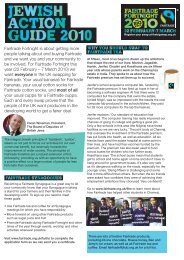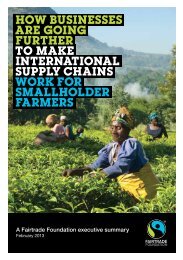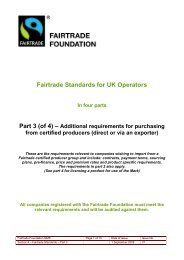Monitoring the scope and benefits of fairtrade
Monitoring the scope and benefits of fairtrade
Monitoring the scope and benefits of fairtrade
You also want an ePaper? Increase the reach of your titles
YUMPU automatically turns print PDFs into web optimized ePapers that Google loves.
<strong>Monitoring</strong> <strong>the</strong> <strong>scope</strong> <strong>and</strong> <strong>benefits</strong> <strong>of</strong> <strong>fairtrade</strong> report third edition, 2011 9<br />
production <strong>of</strong> <strong>the</strong> different products, or <strong>the</strong> relative contribution <strong>of</strong> different products<br />
to Fairtrade Premium income. Improving data relating to diversified production should<br />
be a priority going forward.<br />
1.5 Disclaimer<br />
The monitoring data in this report are based on data collected by FLO-CERT GmbH,<br />
<strong>and</strong> reported by producer organizations through <strong>the</strong> audit process. Fairtrade<br />
International is not responsible for <strong>the</strong> accuracy <strong>of</strong> <strong>the</strong> data. The report has been<br />
compiled to <strong>the</strong> best <strong>of</strong> our knowledge <strong>and</strong> is provided for informational purposes<br />
only. Fairtrade International reserves <strong>the</strong> right to update <strong>the</strong> monitoring data as new<br />
information becomes available. The data are provided “as is” <strong>and</strong> no warranty <strong>of</strong> any<br />
kind is given for <strong>the</strong> accuracy <strong>and</strong> reliability <strong>of</strong> <strong>the</strong> data. Fairtrade International will not<br />
be liable for any claims or damages related to <strong>the</strong> quality <strong>and</strong> completeness <strong>of</strong> <strong>the</strong><br />
data, as far as it is permitted under law.<br />
1.6 Notes on <strong>the</strong> data<br />
■■ The geographical regions used in <strong>the</strong> report are <strong>the</strong> United Nations regions,<br />
which are also adopted within <strong>the</strong> Fairtrade Geographical Scope. A reference<br />
for this can be found at http://<strong>fairtrade</strong>.net/fileadmin/user_upload/content/2009/<br />
st<strong>and</strong>ards/documents/2011-07-01_Geographical_Scope_policy_EN.pdf<br />
■■ In contrast to previous reports, this report uses weighted means for calculating<br />
average values, weighted according to <strong>the</strong> numbers <strong>of</strong> farmers or workers<br />
contributing to <strong>the</strong> value.<br />
■■ There are some cases where data do not sum completely accurately. This is<br />
due to rounding.<br />
■■ Audit reports state financial values in many varying local <strong>and</strong> international<br />
currencies. All financial data have been converted into Euro (€) values, based<br />
on <strong>the</strong> average exchange rate for <strong>the</strong> year in which <strong>the</strong> transaction took place.<br />
■■ All product volume data has been converted into metric tonnes (MT), with <strong>the</strong><br />
exception <strong>of</strong> flowers, which are given as numbers <strong>of</strong> stems, <strong>and</strong> sports balls<br />
which are given as units.<br />
■■ For many products, different product forms exist. Audit reports <strong>of</strong>ten collect data<br />
based on different product forms for <strong>the</strong> same product, <strong>and</strong> sometimes <strong>the</strong> product<br />
form is not clear in <strong>the</strong> report itself, or changes according to <strong>the</strong> indicator. For<br />
example, juice production volumes are <strong>of</strong>ten expressed in terms <strong>of</strong> fresh fruit<br />
volumes produced, while sales volumes are expressed as juice concentrate sold.<br />
All efforts have been made to ensure that data is used in a consistent product<br />
form for each product; never<strong>the</strong>less it is highly likely that <strong>the</strong>re are inaccuracies<br />
arising in <strong>the</strong> data due to product form <strong>and</strong> conversion issues, especially in<br />
cases where <strong>the</strong> form is not clearly indicated in <strong>the</strong> audit reports. The following<br />
products are <strong>of</strong>ten reported in different forms in <strong>the</strong> audit reports. We indicate<br />
here which form we have adopted for <strong>the</strong> monitoring data:<br />
■■ Cocoa: cocoa beans<br />
■■ C<strong>of</strong>fee: green bean equivalent (GBE)<br />
■■ Dried fruit: dried fruit (not fresh)<br />
■■ Fruit juice: juice concentrate (not fruit)<br />
■■ Rice: paddy rice<br />
■■ Seed cotton: seed cotton (not lint)<br />
■■ Sugar: cane sugar (not sugar cane)<br />
■■ Tea: made tea (not green leaf)<br />
■■ Wine grapes: grapes (not wine volumes)<br />
■■ For <strong>the</strong> product categories <strong>of</strong> nuts <strong>and</strong> oilseeds <strong>and</strong> herbs <strong>and</strong> spices <strong>the</strong> in-<br />
category diversity <strong>of</strong> products, combined with lack <strong>of</strong> consistency in reporting,<br />
has made it difficult to ensure that product forms are expressed consistently.


